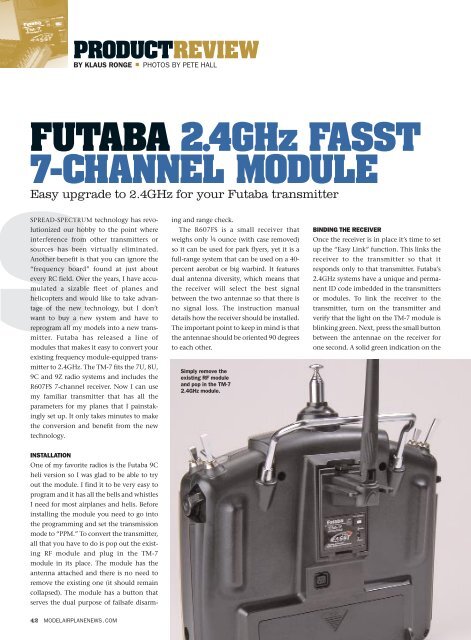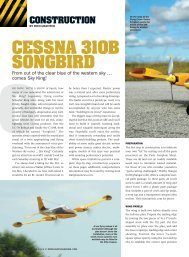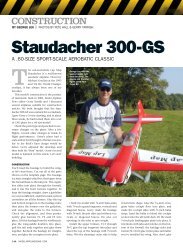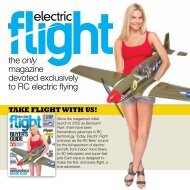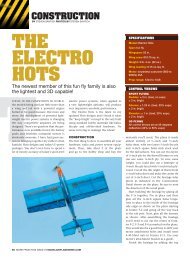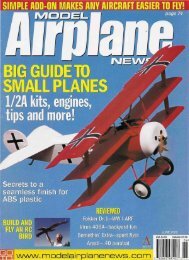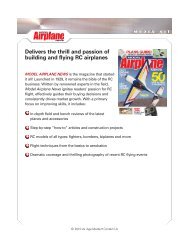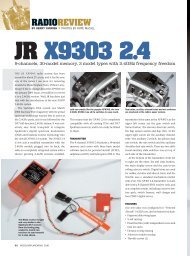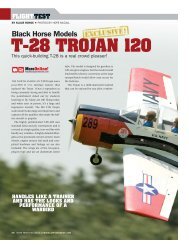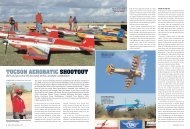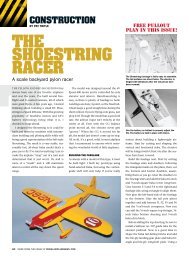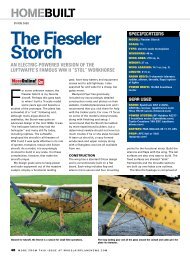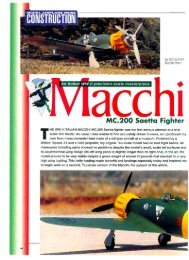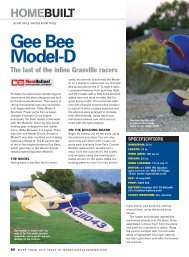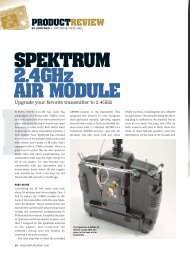FUTABA 2.4GHz FASST 7-CHANNEL MODULE
FUTABA 2.4GHz FASST 7-CHANNEL MODULE
FUTABA 2.4GHz FASST 7-CHANNEL MODULE
You also want an ePaper? Increase the reach of your titles
YUMPU automatically turns print PDFs into web optimized ePapers that Google loves.
PRODUCTREVIEW<br />
BY KLAUS RONGE PHOTOS BY PETE HALL<br />
<strong>FUTABA</strong> <strong>2.4GHz</strong> <strong>FASST</strong><br />
7-<strong>CHANNEL</strong> <strong>MODULE</strong><br />
Easy upgrade to <strong>2.4GHz</strong> for your Futaba transmitter<br />
SPREAD-SPECTRUM technology has revolutionized<br />
our hobby to the point where<br />
interference from other transmitters or<br />
sources has been virtually eliminated.<br />
Another benefit is that you can ignore the<br />
“frequency board” found at just about<br />
every RC field. Over the years, I have accumulated<br />
a sizable fleet of planes and<br />
helicopters and would like to take advantage<br />
of the new technology, but I don’t<br />
want to buy a new system and have to<br />
reprogram all my models into a new transmitter.<br />
Futaba has released a line of<br />
modules that makes it easy to convert your<br />
existing frequency module-equipped transmitter<br />
to <strong>2.4GHz</strong>. The TM-7 fits the 7U, 8U,<br />
9C and 9Z radio systems and includes the<br />
R607FS 7-channel receiver. Now I can use<br />
my familiar transmitter that has all the<br />
parameters for my planes that I painstakingly<br />
set up. It only takes minutes to make<br />
the conversion and benefit from the new<br />
technology.<br />
INSTALLATION<br />
One of my favorite radios is the Futaba 9C<br />
heli version so I was glad to be able to try<br />
out the module. I find it to be very easy to<br />
program and it has all the bells and whistles<br />
I need for most airplanes and helis. Before<br />
installing the module you need to go into<br />
the programming and set the transmission<br />
mode to “PPM.” To convert the transmitter,<br />
all that you have to do is pop out the existing<br />
RF module and plug in the TM-7<br />
module in its place. The module has the<br />
antenna attached and there is no need to<br />
remove the existing one (it should remain<br />
collapsed). The module has a button that<br />
serves the dual purpose of failsafe disarm-<br />
42 MODELAIRPLANENEWS.COM<br />
ing and range check.<br />
The R607FS is a small receiver that<br />
weighs only 1 ⁄4 ounce (with case removed)<br />
so it can be used for park flyers, yet it is a<br />
full-range system that can be used on a 40percent<br />
aerobat or big warbird. It features<br />
dual antenna diversity, which means that<br />
the receiver will select the best signal<br />
between the two antennae so that there is<br />
no signal loss. The instruction manual<br />
details how the receiver should be installed.<br />
The important point to keep in mind is that<br />
the antennae should be oriented 90 degrees<br />
to each other.<br />
Simply remove the<br />
existing RF module<br />
and pop in the TM-7<br />
<strong>2.4GHz</strong> module.<br />
BINDING THE RECEIVER<br />
Once the receiver is in place it’s time to set<br />
up the “Easy Link” function. This links the<br />
receiver to the transmitter so that it<br />
responds only to that transmitter. Futaba’s<br />
<strong>2.4GHz</strong> systems have a unique and permanent<br />
ID code imbedded in the transmitters<br />
or modules. To link the receiver to the<br />
transmitter, turn on the transmitter and<br />
verify that the light on the TM-7 module is<br />
blinking green. Next, press the small button<br />
between the antennae on the receiver for<br />
one second. A solid green indication on the
LED confirms that the receiver and transmitter<br />
are linked. The <strong>2.4GHz</strong> conversion is<br />
now complete and all that’s left is to rangecheck<br />
the system.<br />
AT THE FIELD<br />
Futaba’s Pre-Vision technology scans the<br />
incoming data and corrects any errors,<br />
which greatly enhances the link between<br />
the receiver and transmitter. Futaba also<br />
claims that the servo response to a stick<br />
movement is faster. At the field, I did a<br />
range check by pressing the button on the<br />
module and walking out about 50 steps. On<br />
the Great Planes 1 ⁄4-scale Sukhoi I was flying,<br />
I noticed almost no difference, which is<br />
a good thing. If anything, I felt more connected<br />
to the plane than with the 72MHz<br />
system previously installed. I later tried it<br />
on a 450-size electric heli, which glitches<br />
fairly often on 72MHz, and I have not been<br />
able to find the source of the interference.<br />
The R607FS receiver was immune to the<br />
interference and the heli did not glitch<br />
once even at the crowded flying field. It was<br />
also very nice not having to wait for a frequency<br />
pin to fly.<br />
Although <strong>2.4GHz</strong> technology is new to<br />
the hobby industry, Futaba has been using<br />
it in their industrial radio control systems<br />
for about 15 years. Futaba is also a leader in<br />
industrial automation and they bring their<br />
expertise and background to the RC industry.<br />
The <strong>2.4GHz</strong> modules and systems<br />
exhibit the typical Futaba quality and reliability.<br />
There will be additional modules<br />
available soon including an 8-channel set<br />
and a 14-channel set for the 12FG, 12Z and<br />
14MZ radio systems. Additionally, the modules<br />
will be available as a set with the<br />
receiver, or alone to cover most of the popular<br />
Futaba radios.<br />
Spread-spectrum technology is a quantum<br />
leap for the RC modeler. Now, Futaba<br />
pilots can transform their current radios<br />
quickly and easily to the new technology.<br />
There’s no need to buy a completely new<br />
system and reprogram all your models. I<br />
plan on eventually converting all my models<br />
but I’m not able to convert them all at<br />
once. Now, in a matter of minutes I can<br />
switch between 72MHz and <strong>2.4GHz</strong> with<br />
the same transmitter; I just have to remember<br />
to check to make sure my frequency is<br />
open before turning it on when the <strong>2.4GHz</strong><br />
module is not in place.<br />
See the Source Guide for manufacturers’ contact information.<br />
SPECIFICATIONS<br />
PRODUCT R607FS 7-channel <strong>2.4GHz</strong><br />
<strong>FASST</strong> receiver/TM-7 transmitter module<br />
MANUFACTURER Futaba<br />
DISTRIBUTOR Great Planes<br />
AVAILABLE FOR Futaba 7U, 8U, 9C and<br />
9Z transmitters<br />
FEATURES <strong>2.4GHz</strong> transmitter module<br />
and small, light full-range receiver<br />
PRICE $250 (w/R607F receiver); $160<br />
(transmitter module only)<br />
NOW I CAN USE MY<br />
FAMILIAR<br />
TRANSMITTER<br />
THAT HAS ALL THE<br />
PARAMETERS FOR<br />
MY PLANES<br />
The TM-7 <strong>FASST</strong><br />
module and R607FS<br />
receiver.<br />
JANUARY 2008 43


